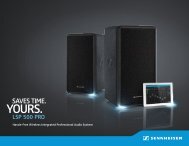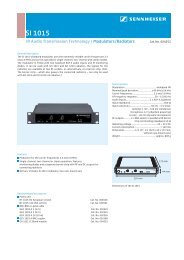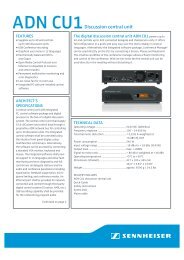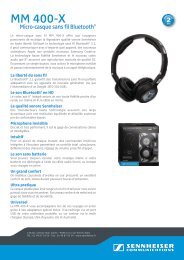MKH 418 S P48 U - Sennheiser
MKH 418 S P48 U - Sennheiser
MKH 418 S P48 U - Sennheiser
Create successful ePaper yourself
Turn your PDF publications into a flip-book with our unique Google optimized e-Paper software.
GEBRAUCHSANLEITUNG<br />
INSTRUCTION MANUAL<br />
NOTICE D´EMPLOI<br />
ISTRUZIONI PER L´USO<br />
INSTRUCCIONES PARA EL USO<br />
GEBRUIKSAANWIJZING<br />
<strong>MKH</strong> <strong>418</strong> S <strong>P48</strong> U
Deutsch 3- 6, 27, 32<br />
English 7-10, 27, 32<br />
Français 11-14, 27, 32<br />
Italiano 15-18, 27, 32<br />
Español 19-22, 27, 32<br />
Nederlands 23-26, 27, 32
<strong>MKH</strong> <strong>418</strong> S <strong>P48</strong> U<br />
MS-Stereo-Kondensatormikrofon<br />
Kurzbeschreibung<br />
Das <strong>MKH</strong> <strong>418</strong> S ist ein MS-Stereomikrofon mit hoher<br />
Richtwirkung für stereophone Aufnahmen des<br />
Originaltons bei Reportagen sowie Film- und<br />
Fernsehaufnahmen. Das Mikrofon ist für 48-V-<br />
Phantomspeisung ausgelegt und arbeitet nach dem<br />
bewährten Hochfrequenzverfahren. Dieses Arbeitsprinzip<br />
gewährleistet auch unter extremen<br />
klimatischen Verhältnissen eine hohe Betriebssicherheit.<br />
Das Mikrofon enthält zwei voneinander unabhängige<br />
akustische Systeme zur Erzeugung des Mitten- und<br />
des Seitensignals. Das Mittensignal (M) wird durch ein<br />
Richtrohrsystem erzeugt. Bei den hohen Frequenzen<br />
ergibt sich eine keulenförmige Richtcharakteristik, bei<br />
den tiefen Frequenzen erfolgt ein Übergang zur<br />
Superniere. Das Seitensignal (S) wird durch eine quer<br />
liegende Acht erzeugt, deren positive Seite nach links<br />
gerichtet ist. M- und S-Signal stehen unabhängig<br />
voneinander am Mikrofonausgang zur Verfügung. Das<br />
Mikrofon ist seitenrichtig orientiert, wenn die<br />
Beschriftung „TOP“ nach oben weist.<br />
Deutsch<br />
Merkmale<br />
• Hoher Bündelungsgrad<br />
• Hoher Übertragungsfaktor<br />
• Niedriges Eigenrauschen<br />
• Robust und extrem klimafest<br />
• Ganzmetallgehäuse, mattschwarz<br />
Lieferumfang<br />
•Mikrofon<br />
•Etui<br />
• Bedienungsanleitung<br />
• Messprotokoll<br />
• Garantieurkunde<br />
<strong>MKH</strong> <strong>418</strong> S 3
Speisung<br />
Deutsch<br />
Das <strong>MKH</strong> <strong>418</strong> S ist für 48-V-Phantomspeisung eingerichtet.<br />
Für den ordnungsgemäßen Betrieb des<br />
Mikrofons müssen immer beide Kanäle zugleich<br />
gespeist werden, auch wenn nur das Signal eines<br />
Kanals benötigt wird. Falls der Mikrofoneingang des<br />
nachfolgenden Gerätes nicht über eine 48-V-Phantomspeisung<br />
verfügt, müssen entsprechende Speisegeräte<br />
zwischengeschaltet werden, z.B. zwei<br />
Batterieadapter MZA 14 <strong>P48</strong> oder ein Netzgerät<br />
N 48 i-2 von Neumann (beide verfügen über 3-polige<br />
XLR-Steckverbindungen) oder ein Batteriegerät<br />
BS 48 i-2 von Neumann (mit 5-poligen XLR-<br />
Steckverbindungen). Der Batterieadapter MZA 14 <strong>P48</strong><br />
ermöglicht auch den Betrieb an unsymmetrischen<br />
Eingängen.<br />
Das <strong>MKH</strong> <strong>418</strong> S wird über ein 5-poliges XLR-Kabel<br />
angeschlossen. Der Ausgangsstecker des <strong>MKH</strong> <strong>418</strong> S<br />
ist normgemäß beschaltet:<br />
Stift 1 = Gehäuse/Masse<br />
Stift 2 = M-Kanal (+)<br />
Stift 3 = M-Kanal (-)<br />
Stift 4 = S-Kanal (+)<br />
Stift 5 = S-Kanal (-).<br />
Zubehör<br />
Für das <strong>MKH</strong> <strong>418</strong> S ist folgendes Zubehör erhältlich:<br />
• Schwinghalterungsset MZS 20-1<br />
• Tischfuß MZT 100<br />
• Tischfuß MZT 441<br />
• Windschutzhülle MZH 60-1<br />
• Windschutzkorb MZW 60-1<br />
• Windschutz MZW 415<br />
• Adapterkabel AC 20, 5-pol. ➜ 2 x 3-pol., XLR, 1 m<br />
Bestellung über den zuständigen Vertriebspartner der<br />
Firma <strong>Sennheiser</strong>.<br />
4 <strong>MKH</strong> <strong>418</strong> S
Anmerkungen zur MS-Stereofonie<br />
Das MS-Signalformat des <strong>MKH</strong> <strong>418</strong> S ermöglicht es<br />
auf besonders einfache Weise, die optimale Balance<br />
zwischen der Hauptinformation des M-Kanals und<br />
dem Räumlichkeitsbeitrag des S-Kanals einzustellen.<br />
Dieser Abgleich ist auch noch während einer<br />
Nachbearbeitung ohne Informationsverlust möglich,<br />
wenn die MS-Originalsignale aufgezeichnet wurden.<br />
Die Umwandlung des MS-Signalformats in das<br />
hörgerechte XY-Format erfolgt durch Addition und<br />
Subtraktion der Signale nach dem Schema: X = M + S,<br />
Y = M – S (Matrizierung). Der Anteil des S-Signals<br />
beeinflusst den Räumlichkeitseffekt und sollte jeweils<br />
passend zur Aufnahmesituation gewählt werden. Um<br />
die Gestaltungsmöglichkeit nicht einzuschränken,<br />
wurde auf eine MS-XY-Matrizierung im Mikrofon<br />
verzichtet.<br />
Falls im Mischpult keine Matrixschaltung verfügbar ist,<br />
kann die Matrizierung nach dem 3-Regler-Verfahren<br />
erfolgen (siehe Skizze).<br />
Deutsch<br />
M<br />
S<br />
+ + -<br />
L<br />
R<br />
3dB<br />
Das M-Signal wird über den ersten Mikrofonkanal mit<br />
dem Panoramaregler auf die Mitte der Stereobasis<br />
positioniert. Das S-Signal wird parallel auf den zweiten<br />
und dritten Kanal gelegt. Der Panoramaregler des<br />
zweiten Kanals wird ganz nach links und der des<br />
<strong>MKH</strong> <strong>418</strong> S 5
Deutsch<br />
dritten Kanals ganz nach rechts gedreht. Die Phase<br />
des rechten Kanals wird außerdem invertiert. Die<br />
Regler der beiden S-Kanäle werden mechanisch oder<br />
elektrisch miteinander gekoppelt. Mit der Stellung der<br />
S-Regler im Verhältnis zum M-Regler lässt sich der<br />
Räumlichkeitseffekt kontinuierlich beeinflussen. Mit<br />
dem in der Skizze beispielhaft dargestellten Versatz<br />
der Regler um 3 dB wird eine Matrizierung im<br />
Verhältnis 1:1 erreicht.<br />
Bei der Matrizierung sollte berücksichtigt werden, dass<br />
die Ortbarkeit nicht axial einfallender Schallsignale<br />
(Off-Bereich) bei den hohen Frequenzen wegen der<br />
zunehmenden Bündelung des Richtrohrs immer mehr<br />
abnimmt. Dadurch können sich diffuse Räumlichkeitseffekte<br />
ergeben, die abhängig von der Aufnahmesituation<br />
erwünscht oder störend sein können. Im<br />
Zweifelsfall sollte der Anteil des S-Signals nicht zu<br />
groß gewählt werden. Eventuell muss am Mischpult<br />
eine geeignete Höhenabsenkung im S-Kanal vorgenommen<br />
werden. Bei den tiefen Frequenzen unter<br />
300 Hz ist die Ortung hörphysiologisch stark<br />
eingeschränkt. Da das S-System des Mikrofons<br />
prinzipbedingt empfindlicher als das M-System auf<br />
tieffrequente, beispielsweise durch Wind verursachte<br />
Störungen reagiert, sollten im S-Kanal gegebenenfalls<br />
die Tiefen abgesenkt werden.<br />
Technische Daten<br />
Akustische Arbeitsweise<br />
Richtcharakteristik<br />
Übertragungsfaktor<br />
bei 1000 Hz<br />
Übertragungsbereich<br />
Grenzschalldruck<br />
Maximale Ausgangsspannung<br />
Ersatzgeräuschpegel<br />
Ausgangsimpedanz bei 1000 Hz<br />
Minimale Lastimpedanz<br />
Speisung<br />
Stecker<br />
Abmessungen<br />
Gewicht<br />
Arbeitstemperaturbereich -20 ... +60 °C<br />
Feuchtigkeitsbereich < 95 % r. F.<br />
M: Druckgradienten-<br />
Interferenzempfänger<br />
S: Druckgradientenempfänger<br />
M: Superniere / Keule<br />
S: Acht<br />
M: 25 mV/Pa (-32 dBV)<br />
S: 10 mV/Pa (-40 dBV)<br />
40 - 20000 Hz<br />
130 dB SPL (63 Pa)<br />
1,5 V<br />
M: 14 dB-A / 26 dB-CCIR<br />
S: 22 dB-A / 34 dB-CCIR<br />
< 25 Ω<br />
1 kΩ<br />
<strong>P48</strong>: 48 ± 4 V / 2 x 2,3 mA<br />
XLR-5M<br />
Ø 19 mm x 280 mm<br />
220 g<br />
6 <strong>MKH</strong> <strong>418</strong> S
<strong>MKH</strong> <strong>418</strong> S <strong>P48</strong> U<br />
MS Stereo Condenser Microphone<br />
Brief Description<br />
The <strong>MKH</strong> <strong>418</strong> S is an MS stereo microphone. Its high<br />
degree of directivity makes the <strong>MKH</strong> <strong>418</strong> S the ideal<br />
choice for stereophonic recordings for reporting, film<br />
and television applications.<br />
The microphone is designed for 48 V phantom<br />
powering and operates using the RF principle. This<br />
principle ensures high operational reliability, even<br />
under extreme climatic conditions.<br />
The <strong>MKH</strong> <strong>418</strong> S has two independent acoustic<br />
systems for generating the mid and side signals. The<br />
mid signal (M) is generated by a shotgun microphone<br />
system. At high frequencies, this results in a lobar<br />
pick-up pattern, whereas at low frequencies there is a<br />
transition to a super-cardioid characteristic. The side<br />
signal (S) is produced by a figure-of-eight capsule,<br />
whose positive side is directed to the left. The M and S<br />
signals are available independently at the microphone<br />
output. The microphone is positioned correctly when<br />
the word "TOP” is pointing upwards.<br />
English<br />
Features<br />
• Excellent directivity<br />
• High sensitivity<br />
• Low inherent self-noise<br />
• Rugged and suitable for adverse climatic conditions<br />
• Matt black all-metal casing<br />
Delivery includes<br />
• Microphone<br />
• Transport case<br />
• Instruction manual<br />
• Test certificate<br />
• Document of warranty<br />
Powering<br />
The <strong>MKH</strong> <strong>418</strong> S is designed for 48 V phantom<br />
powering. To ensure proper operation of the<br />
microphone, the two channels always have to be<br />
<strong>MKH</strong> <strong>418</strong> S 7
English<br />
powered simultaneously, even if only the signal of one<br />
channel is required. If no 48 V phantom powering is<br />
available at the microphone input of the subsequent<br />
device, suitable power supply units must be<br />
interconnected, e.g. two MZA 14 <strong>P48</strong> battery power<br />
supply units or one Neumann N 48 i-2 mains power<br />
supply unit (both units are fitted with a 3-pin XLR<br />
connector) or one Neumann BS 48 i-2 battery power<br />
supply unit (fitted with a 5-pin XLR connector). The<br />
MZA 14 <strong>P48</strong> battery power supply unit also allows<br />
direct connection to unbalanced inputs.<br />
Also suitable is the MZA MS-1 (available from<br />
<strong>Sennheiser</strong> UK). This is a battery power supply, with<br />
5-pin XLR input and output, that incorporates an<br />
MS matrix amplifier and microphone pre-amplifier. The<br />
unit enables an MS microphone to output left/right<br />
stereo and incorporates a ch-2 phase-reverse switch,<br />
bass roll-off and adjustable level and width controls.<br />
Output level is switchable microphone or line.<br />
The <strong>MKH</strong> <strong>418</strong> S is connected via a 5-pin XLR cable.<br />
The connector of the <strong>MKH</strong> <strong>418</strong> S has standard pin<br />
assignment:<br />
Pin 1 = Casing/ground<br />
Pin 2 = M channel (+)<br />
Pin 3 = M channel (-)<br />
Pin 4 = S channel (+)<br />
Pin 5 = S channel (-)<br />
Accessories<br />
The following accessories are available:<br />
• MZS 20-1 Suspension/pistol grip<br />
• MZT 100 Table stand<br />
• MZT 441 Table stand<br />
• MZH 60-1 “Hairy” cover<br />
• MZW 60-1 Basket windshield<br />
• MZW 415 Foam windshield<br />
• Y-Cable AC 20 XLR-5F / 2 x XLR-3M, 1 m length<br />
Please order from your local <strong>Sennheiser</strong> dealer.<br />
Notes on MS Stereo Sound Recording<br />
The MS signal format of the <strong>MKH</strong> <strong>418</strong> S provides a<br />
particularly easy means of setting the optimum<br />
8 <strong>MKH</strong> <strong>418</strong> S
alance between the main information of the mid<br />
channel and the spatial contribution of the side<br />
channel. This balancing can even be performed during<br />
re-processing without a loss of information if the<br />
original MS signals were recorded.<br />
The MS signal format is converted into the XY format<br />
(ie: standard left/right stereo) by adding or subtracting<br />
the signals according to the principle X = M + S,<br />
Y = M – S. The proportion of the S signal influences<br />
the spatial effect and should be chosen in each case in<br />
accordance with the recording situation. In order to<br />
avoid restricting the possibilities of designing the<br />
sound impression, MS – XY matrixing in the<br />
microphone was not employed.<br />
If a matrix circuit is not available on the mixing<br />
console, matrixing can be performed using the 3-fader<br />
method (see diagram). The M signal is connected to<br />
English<br />
M<br />
S<br />
+ + -<br />
L<br />
R<br />
3dB<br />
the first microphone channel and panned centre. The<br />
S signal is connected to the second channel and<br />
panned full left. Take an output from the second<br />
channel and connect to the third channel panned full<br />
right and phase reversed (via a phase reverse switch<br />
or via the cable). (To set the correct S signal level - set<br />
the pan controls of channel two to central, set the main<br />
fader to normal level and set the correct level at the<br />
preset. Then, set the pan control of channel 3 to<br />
centre, set the main fader to the same level as channel<br />
two and then adjust the pre-set of channel three until<br />
<strong>MKH</strong> <strong>418</strong> S 9
English<br />
the signal totally disappears – the two channels are<br />
now set identical – now pan channel two fully left and<br />
channel three fully right for normal operation).<br />
Channels two and three are controlled as a single<br />
fader (mechanically or electrically coupled together).<br />
The stereo width is controlled by the relative levels –<br />
less side is a narrower image, more side is a wider<br />
image. The displacement of the faders by 3 dB, as<br />
shown in the diagram as an example, results in 1:1<br />
ratio matrixing.<br />
During matrixing, it should be taken into account that<br />
the direction of off-axis sound signals can be<br />
determined less and less at high frequencies due to<br />
the increasing directivity of the shotgun microphone.<br />
This may lead to diffused spatial effects, which can be<br />
desirable or undesirable depending on the recording<br />
situation. In case of doubt, the proportion of the S<br />
signal should not be chosen too high. In some cases, it<br />
might be necessary to reduce the treble in the S<br />
channel on the mixing console. At low frequencies<br />
below 300 Hz, it is very difficult to locate sounds for<br />
physiological reasons. Since the S system of the<br />
microphone, due to its design principle, is more<br />
sensitive than the M system to low-frequency<br />
interference caused for example by wind, the bass in<br />
the S channel should be reduced if required (eg: with a<br />
high-pass filter).<br />
Specifications<br />
Acoustic operating principle M: pressure gradient /<br />
interference tube receiver<br />
S: pressure gradient receiver<br />
Pick-up pattern<br />
M: super-cardioid/lobar<br />
S: figure-of-eight<br />
Sensitivity at 1000 Hz M: 25 mV/Pa (-32 dBV)<br />
S: 10 mV/Pa (-40 dBV)<br />
Frequency response<br />
40 - 20,000 Hz<br />
Max. SPL<br />
130 dB SPL (63 Pa)<br />
Max. output voltage<br />
1.5 V<br />
Equivalent noise level M: 14 dB-A / 26 dB-CCIR<br />
S: 22 dB-A / 34 dB-CCIR<br />
Output impedance at 1000 Hz < 25 Ω<br />
Min. load impedance 1 kΩ<br />
Power supply<br />
<strong>P48</strong>: 48 ± 4 V / 2 x 2.3 mA<br />
Connector<br />
5-pin XLR, male<br />
Dimensions<br />
Ø 19 mm x 280 mm<br />
Weight<br />
220 g<br />
Operating temperature range -20 to +60 °C<br />
Humidity range<br />
< 95 % relative humidity<br />
10 <strong>MKH</strong> <strong>418</strong> S
Microphone électrostatic stéréo M-S<br />
<strong>MKH</strong> <strong>418</strong> S <strong>P48</strong> U<br />
Description<br />
Le <strong>MKH</strong> <strong>418</strong> S est un microphone stéréophonique<br />
M-S. Sa directivité prononcée en fait un choix idéal<br />
pour les enregistrements stéréo à effectuer lors de<br />
reportages, sur des tournages cinéma ou télévision.<br />
Le <strong>MKH</strong> <strong>418</strong> S demande une tension d’alimentation<br />
48 Volts, et utilise le principe de fonctionnement<br />
HF (polarisation haute fréquence), spécifique à la<br />
gamme de micros <strong>Sennheiser</strong> <strong>MKH</strong>. Ce principe<br />
assure une fiabilité de fonctionnement optimale, même<br />
dans des conditions climatiques extrêmes.<br />
Le <strong>MKH</strong> <strong>418</strong> S dispose de deux transducteurs électroacoustiques<br />
indépendants pour générer les signaux<br />
M et S. Le signal médian (M pour « Middle », milieu)<br />
est capté par un micro canon. Aux fréquences<br />
élevées, la directivité ainsi obtenue présente une<br />
forme de lobe, tandis qu’aux fréquences plus basses,<br />
elle évolue progressivement vers une courbe<br />
supercardioïde caractéristique. Le signal latéral<br />
(S pour « Side », côté) est capté par un micro<br />
bidirectionnel neutre, dont le côté positif est dirigé vers<br />
la gauche. Le connecteur multibroche de sortie du<br />
microphone permet de récupérer indépendamment les<br />
signaux M et S. Pour placer correctement le micro, il<br />
faut que le mot « TOP » soit dirigé vers le haut.<br />
Français<br />
Caractéristiques<br />
• Excellente directivité<br />
• Efficacité élevée<br />
• Bruit propre très faible<br />
• Robuste, convient à des conditions climatiques<br />
défavorables<br />
• Corps métal noir mat<br />
L’emballage contient :<br />
• Microphone<br />
• Mallette de transport<br />
• Notice d’emploi<br />
• Fiche de contrôle<br />
• Document de garantie<br />
<strong>MKH</strong> <strong>418</strong> S 11
Alimentation<br />
Français<br />
Le <strong>MKH</strong> <strong>418</strong> S est prévu pour une alimentation via<br />
tension fantôme 48 Volts. Pour que le microphone<br />
puisse fonctionner correctement, il faut toujours<br />
alimenter les deux canaux simultanément, même si un<br />
seul signal est requis. Si l’appareil auquel le<br />
microphone est relié est incapable de fournir une<br />
tension fantôme 48 Volts, il faut insérer des<br />
alimentations indépendantes : par exemple, deux<br />
<strong>Sennheiser</strong> MZA 14 <strong>P48</strong> (alimentations fantômes 48 V<br />
sur pile 9 V), ou une alimentation 48 V secteur<br />
Neumann N 48 i-2 (toutes deux équipées d’un<br />
connecteur XLR 3 contacts) ou une alimentation 48 V<br />
à pile pour 2 micros Neumann BS 48 i-2 (possédant<br />
un connecteur XLR 5 broches). L’alimentation à pile<br />
MZA 14 <strong>P48</strong> permet par ailleurs un branchement<br />
direct sur des entrées asymétriques.<br />
Le câble audio du <strong>MKH</strong> 41 S est pourvu de<br />
connecteurs XLR 5 contacts, dont voici l’assignation :<br />
Contact 1 = Corps/masse<br />
Contact 2 = Point chaud canal M (+)<br />
Contact 3 = Point froid canal M (-)<br />
Contact 4 = Point chaud canal S (+)<br />
Contact 5 = Point froid canal S (-)<br />
Accessoires<br />
Voici les différents accessoires disponibles pour le<br />
<strong>MKH</strong> <strong>418</strong> S :<br />
• Réglette avec suspension et poignée revolver<br />
MZS 20-1<br />
• Pied de table lourd MZT 100<br />
• Pied de table MZT 441<br />
• Enveloppe de bonnette MZH 60-1<br />
• Bonnette armée MZW 60-1<br />
• Bonnette mousse MZW 415<br />
• Câble adaptateur AC 20, 5-pol. ➜ 2 x 3-pol., XLR, 1<br />
m<br />
Pour toute commande, adressez-vous à votre<br />
revendeur local <strong>Sennheiser</strong>.<br />
12 <strong>MKH</strong> <strong>418</strong> S
À propos de l’enregistrement stéréo M-S<br />
Le format de signal M-S du <strong>MKH</strong> <strong>418</strong> S permet de<br />
doser facilement l’équilibre entre l’information<br />
principale, captée par le micro central (M) et les<br />
informations « spatiales » délivrées par le micro latéral<br />
(S). Vous pouvez même effectuer ce dosage après<br />
l’enregistrement, sans aucune perte si vous avez pris<br />
la précaution d’enregistrer les deux signaux M et S tels<br />
quels sur des pistes séparées. Le signal M-S est<br />
ensuite converti au format X-Y (micros coïncidents),<br />
qui permet une écoute stéréophonique classique,<br />
selon la formule suivante : X = M + S, Y = M – S<br />
(matriceur). Ce processus s’appelle le matriçage. La<br />
proportion de signal S détermine la largeur stéréo,<br />
autrement dit l’impression d’espace sonore, il faut<br />
donc doser le signal S avec soin, en fonction de la<br />
situation d’enregistrement. Pour éviter tout compromis<br />
et laisser une latitude de choix maximale à<br />
l’utilisateur, le <strong>MKH</strong> <strong>418</strong> S n’intègre pas de matriceur<br />
M-S —> X-Y en sortie.<br />
Si votre table de mixage ne propose pas de fonction<br />
de matriçage, vous pouvez utiliser la méthode dite<br />
« des trois faders » (voir schéma). Il faut envoyer le<br />
Français<br />
M<br />
S<br />
+ + -<br />
L<br />
R<br />
3dB<br />
signal M sur le premier fader, et panoramiquer le<br />
signal au centre de l’image stéréo. Le signal S doit être<br />
envoyé sur deux voies de consoles à la fois ; le<br />
potentiomètre de panoramique de l’une à fond à<br />
gauche, celui de l’autre voie à fond à droite, et il faut<br />
inverser la phase du canal droit. Les faders des deux<br />
voies S doivent être couplés, mécaniquement ou<br />
électroniquement.<br />
<strong>MKH</strong> <strong>418</strong> S 13
Français<br />
Pour doser la largeur stéréo, donc l’impression<br />
d’espace sonore, il suffit de modifier le niveau du canal<br />
S par rapport au canal M. La position « nominale »<br />
(taux de matriçage 1:1) s’obtient pour un déplacement<br />
des faders de 3 dB, comme indiqué dans le schéma.<br />
Au cours du matriçage, il faut tenir compte du fait que<br />
la provenance des signaux sonores hors axe est de<br />
moins en moins perceptible dans les aigus, à cause de<br />
la directivité accrue du micro canon M. Il peut en<br />
résulter un « affadissement » du rendu de l’espace<br />
sonore, acceptable ou non selon le type<br />
d’enregistrement.<br />
En cas de doute, mieux vaut ne pas exagérer la<br />
proportion de signal S. Dans certains cas, il peut être<br />
nécessaire d’atténuer un peu, sur la console, les aigus<br />
du canal S. Aux fréquences graves inférieures à<br />
300 Hz, pour des raisons physiologiques, il devient<br />
très difficile de repérer la provenance des sons.<br />
Comme le transducteur S du microphone est, par<br />
construction, plus sensible que le transducteur M aux<br />
interférences dans les graves, provoquées par<br />
exemple par le vent, il ne faut pas hésiter, si<br />
nécessaire, à atténuer les graves sur la voie S de la<br />
console.<br />
Caractéristiques<br />
Principe acoustique<br />
de fonctionnement<br />
Directivité<br />
Sensibilité à 1000 Hz<br />
M : transducteur à gradient de<br />
pression + tube à interférences<br />
S : transducteur à gradient de<br />
pression<br />
M : supercardioïde/lobe<br />
S : bidirectionnelle<br />
M : 25 mV/Pa (soit -32 dBV)<br />
S : 10 mV/Pa (soit -40 dBV)<br />
40 - 20000 Hz<br />
Réponse en fréquence<br />
Niveau maxi de pression sonore 130 dB SPL (63 Pa)<br />
Tension de sortie maximale 1,5 V<br />
Niveau de bruit équivalent<br />
M : 14 dB-A / 26 dB-CCIR<br />
S : 22 dB-A / 34 dB-CCIR<br />
Impédance de sortie à 1000 Hz < 25 Ω<br />
Impédance de charge minimale 1 kΩ<br />
Alimentation fantôme<br />
48 ± 4 V / 2 x 2,3 mA<br />
Connecteur<br />
XLR 5 contacts, mâle<br />
Dimensions<br />
Ø 19 mm x 280 mm<br />
Poids<br />
220 g<br />
Température de fonctionnement de -20 à +60 °C<br />
Taux d’hygrométrie<br />
< 95 % d’humidité relative<br />
14 <strong>MKH</strong> <strong>418</strong> S
Microfono a condensatore stereo a segnale<br />
centrale e laterale <strong>MKH</strong> <strong>418</strong> S <strong>P48</strong> U<br />
Breve descrizione<br />
L'<strong>MKH</strong> <strong>418</strong> S <strong>P48</strong> U è un microfono per stereo a<br />
segnale centrale e laterale con direttività elevata per<br />
registrazioni stereofoniche del tono originale durante<br />
reportage e riprese cinematografiche e televisive. Il<br />
microfono è predisposto per l'alimentazione a canali<br />
fantasma da 48 V e funziona in base al comprovato<br />
processo ad alta frequenza. Questo principio di lavoro<br />
garantisce una sicurezza d'esercizio elevata anche in<br />
condizioni climatiche estreme.<br />
Il microfono contiene due sistemi acustici indipendenti<br />
l'uno dall'altro per la generazione del segnale centrale<br />
e del segnale laterale. Il segnale centrale (M) viene<br />
generato da un sistema a tubi direzionali. A frequenze<br />
elevate, viene a determinarsi una caratteristica<br />
direzionale a forma di lobo, mentre a frequenze ridotte<br />
si verifica un passaggio al supercardioide. Il segnale<br />
laterale (S) viene generato da un otto trasversale, il cui<br />
lato positivo è orientato verso sinistra. I segnali M e S<br />
sono a disposizione sull'uscita del microfono,<br />
indipendentemente l'uno dall'altro. Il microfono è<br />
orientato lateralmente se la scritta "TOP" è rivolta<br />
verso l'alto.<br />
Caratteristiche<br />
• Grado di concentrazione elevato<br />
• Fattore di trasmissione elevato<br />
• Rumore di fondo ridotto<br />
• Resistenza agli agenti atmosferici robusta ed elevata<br />
• Alloggiamento completamente in metallo, nero<br />
opaco<br />
Italiano<br />
Materiale in dotazione<br />
• Microfono<br />
• Custodia<br />
• Istruzioni per l'uso<br />
• Protocollo di misurazione<br />
• Documento di garanzia<br />
<strong>MKH</strong> <strong>418</strong> S 15
Alimentazione<br />
Il microfono <strong>MKH</strong> <strong>418</strong> S è predisposto per<br />
l'alimentazione a canali fantasma da 48 V. Per il<br />
funzionamento regolare del microfono devono essere<br />
sempre alimentati contemporaneamente entrambi i<br />
canali, anche quando è necessario solo il segnale di<br />
un canale. Se l'ingresso del microfono<br />
dell'apparecchio inserito a valle non dispone di<br />
un'alimentazione a canali fantasma da 48 V, occorre<br />
inserire apparecchi di alimentazione rispettivi, ad es.<br />
due adattatori a batteria MZA 14 <strong>P48</strong> o un<br />
alimentatore N 48 i-2 di Neumann (entrambi<br />
dispongono di collegamenti a spina XLR a 3 poli) o un<br />
apparecchio a batteria BS 48 i-2 di Neumann (con<br />
collegamenti a spina XLR a 5 poli). L'adattatore a<br />
batteria MZA 14 <strong>P48</strong> consente anche il funzionamento<br />
su ingressi asimmetrici.<br />
Il microfono <strong>MKH</strong> <strong>418</strong> S viene collegato per mezzo di<br />
un cavo XLR a 5 poli. Il connettore d'uscita del<br />
microfono <strong>MKH</strong> <strong>418</strong> S è cablato a norma:<br />
Italiano<br />
Spina 1 = alloggiamento/massa<br />
Spina 2 = canale M (+)<br />
Spina 3 = canale M (-)<br />
Spina 4 = canale S (+)<br />
Spina 5 = canale S (-)<br />
Accessori<br />
Per il microfono <strong>MKH</strong> <strong>418</strong> S sono disponibili i seguenti<br />
accessori:<br />
• Set di supporto orientabile MZS 20-1<br />
• Piede da tavolo MZT 100<br />
• Piede da tavolo MZT 441<br />
• Guaina paravento MZH 60-1<br />
• Cestello paravento MZW 60-1<br />
• Paravento MZW 415<br />
• Cavo adattatore AC 20, 5-pol. ➜ 2 x 3-pol., XLR, 1 m<br />
Ordinazione tramite i partner distributori <strong>Sennheiser</strong><br />
competenti.<br />
16 <strong>MKH</strong> <strong>418</strong> S
Note sulla stereofonia a segnale centrale e laterale<br />
Il formato dei segnali centrali e laterali del microfono<br />
<strong>MKH</strong> <strong>418</strong> S consente di regolare in maniera<br />
particolarmente semplice l'equilibrio ottimale tra le<br />
informazioni principali del canale M ed il contributo<br />
stereofonico del canale S. Questa compensazione è<br />
possibile anche durante una rielaborazione senza<br />
perdita di informazioni, se i segnali originali centrali e<br />
laterali sono stati registrati.<br />
La trasformazione del formato dei segnali MS nel<br />
formato XY adeguato all'orecchio umano avviene per<br />
mezzo dell'aggiunta e della sottrazione dei segnali in<br />
base allo schema: X = M + S, Y = M – S (matrice). La<br />
parte del segnale S influisce sull'effetto stereofonico e<br />
dovrebbe essere scelta di volta in volta in modo<br />
adeguato alla situazione di registrazione. Per non<br />
limitare la possibilità di configurazione, si è rinunciato<br />
alla generazione di una matrice MS-XY nel microfono.<br />
Se nel pannello di mixaggio non è disponibile alcun<br />
circuito a matrici, la matrice può essere realizzata in<br />
base al processo a 3 regolatori (vedere schizzo). Il<br />
M<br />
S<br />
+ + -<br />
Italiano<br />
L<br />
R<br />
3dB<br />
segnale M viene posizionato sul primo canale del<br />
microfono con il regolatore panoramico al centro della<br />
base stereo. Il segnale S viene posizionato<br />
parallelamente al secondo ed al terzo canale. Il<br />
regolatore panoramico del secondo canale viene<br />
ruotato completamente verso sinistra e quello del terzo<br />
canale completamente verso destra. La fase del<br />
canale destro viene inoltre invertita. I regolatori dei due<br />
canali S vengono accoppiati l'uno all'altro<br />
meccanicamente o elettricamente. Con la posizione<br />
dei regolatori S in relazione al regolatore M, è possibile<br />
<strong>MKH</strong> <strong>418</strong> S 17
influire continuamente sull'effetto stereofonico. Con lo<br />
sfasamento dei regolatori di 3 dB illustrato nello<br />
schizzo a titolo di esempio, si ottiene una generazione<br />
di matrice in un rapporto 1:1.<br />
Durante la generazione della matrice, occorre<br />
prendere in considerazione il fatto che la possibilità di<br />
localizzazione dei segnali acustici ad incidenza non<br />
assiale (campo off) diminuisce sempre più a frequenze<br />
elevate a causa della concentrazione incrementale del<br />
tubo di orientamento. In questo modo, possono venire<br />
a determinarsi effetti stereofonici diffusi che possono<br />
essere desiderati o indesiderati a seconda della<br />
situazione di ripresa. In caso di dubbi, la parte del<br />
segnale S non dovrebbe essere impostata ad un<br />
valore eccessivo. Eventualmente, sul pannello di<br />
mixaggio occorre eseguire una diminuzione<br />
dell'altezza adatta nel canale S. A frequenze inferiori a<br />
300 Hz, la localizzazione è fortemente limitata per<br />
ragioni fisiologiche dell'udito. Poiché, dato il loro<br />
diverso principio, il sistema S del microfono reagisce in<br />
modo più sensibile del sistema M ai disturbi di bassa<br />
frequenza causati ad esempio dal vento, nel canale S<br />
potrebbe essere eventualmente opportuno diminuire i<br />
bassi.<br />
Dati tecnici<br />
Italiano<br />
Funzionamento acustico<br />
M: microfono interferenziale a<br />
gradiente di pressione<br />
S: microfono a gradiente di<br />
pressione<br />
Caratteristica direzionale M: supercardioide/lobo<br />
S: otto<br />
Fattore di trasmissione<br />
M: 25 mV/Pa (-32 dBV)<br />
a 1000 Hz<br />
S: 10 mV/Pa (-40 dBV)<br />
Intervallo di trasmissione 40 - 20000 Hz<br />
Pressione acustica limite 130 dB SPL (63 Pa)<br />
Tensione d'uscita massima 1,5 V<br />
Livello di rumore sostitutivo M: 14 dB-A / 26 dB-CCIR<br />
S: 22 dB-A / 34 dB-CCIR<br />
Impedenza d'uscita a 1000 Hz < 25 Ω<br />
Impedenza di carico minima 1 kΩ<br />
Alimentazione<br />
<strong>P48</strong>: 48 ± 4 V / 2 x 2,3 mA<br />
Connettore<br />
XLR-5M<br />
Dimensioni<br />
Ø 19 mm x 280 mm<br />
Peso<br />
220 g<br />
Intervallo delle temperature<br />
d'esercizio da -20 a +60 °C<br />
Intervallo di umidità < 95% u. r.<br />
18 <strong>MKH</strong> <strong>418</strong> S
<strong>MKH</strong> <strong>418</strong> S <strong>P48</strong> U<br />
Micrófono de condensador stereo MS<br />
Descripción breve<br />
El <strong>MKH</strong> <strong>418</strong> S es un micrófono estéreo MS con<br />
elevado efecto direccional para grabaciones<br />
estereofónicas del sonido original en reportajes, así<br />
como en grabaciones de películas y de televisión. El<br />
micrófono está diseñado para alimentación Phantom a<br />
48 V y trabaja según el acreditado procedimiento de<br />
alta frecuencia. Este principio de trabajo garantiza<br />
también bajo condiciones climáticas extremas una<br />
elevada seguridad de funcionamiento.<br />
El micrófono contiene dos sistemas acústicos<br />
independientes entre sí para la generación de las<br />
señales central y lateral. La señal central (M) se<br />
genera por un sistema de tubo direccional. Con las<br />
frecuencias agudas resulta una característica<br />
direccional en forma de lóbulo, con las frecuencias<br />
graves se realiza una transición a supercardioide. La<br />
señal lateral (S) se genera por un ocho situado<br />
transversalmente, cuya cara positiva está dirigida<br />
hacia la izquierda. Las señales M y S están<br />
disponibles en la salida del micrófono independientes<br />
entre sí. El micrófono está orientado en dirección<br />
lateral, cuando la inscripción "TOP" mira hacia arriba.<br />
Características<br />
• Elevado índice de concentración<br />
• Elevado factor de transmisión<br />
• Bajo ruido propio<br />
• Robusto y extremadamente resistente a los cambios<br />
climáticos<br />
• Carcasa toda de metal, negro mate<br />
Alcance del suministro<br />
• Micrófono<br />
• Estuche<br />
• Instrucciones para el uso<br />
• Acta de medición<br />
• Certificado de garantía<br />
Español<br />
<strong>MKH</strong> <strong>418</strong> S 19
Alimentación<br />
El micrófono <strong>MKH</strong> <strong>418</strong> S está preparado para<br />
alimentación Phantom a 48 V. Para el funcionamiento<br />
correcto del micrófono, siempre se deben alimentar al<br />
mismo tiempo los dos canales, incluso aunque sólo se<br />
necesite la señal de un canal. En caso de que la<br />
entrada del micrófono del aparato siguiente no<br />
disponga de una alimentación Phantom a 48 V, se<br />
deben interconectar los correspondientes aparatos<br />
alimentadores, por ejemplo, dos adaptadores de<br />
baterías MZA 14 <strong>P48</strong> o un aparato alimentado por la<br />
red N 48 i-2 de Neumann (ambos disponen de<br />
conexiones de enchufe XLR de 3 polos), o un aparato<br />
de batería BS 48 i-2 de Neumann (con conexiones de<br />
enchufe XLR de 5 polos). El adaptador de batería<br />
MZA 14 <strong>P48</strong> posibilita también el funcionamiento en<br />
entradas asimétricas.<br />
El <strong>MKH</strong> <strong>418</strong> S se conecta por medio de un cable XLR<br />
de 5 polos. La clavija de salida del <strong>MKH</strong> <strong>418</strong> S está<br />
cableada normalmente:<br />
Patilla 1 = Carcasa / masa<br />
Patilla 2 = Canal M (+)<br />
Patilla 3 = Canal M (-)<br />
Patilla 4 = Canal S (+)<br />
Patilla 5 = Canal S (-).<br />
Accesorios<br />
Para el <strong>MKH</strong> <strong>418</strong> S están disponibles los siguientes<br />
accesorios:<br />
Español<br />
• Conjunto soporte antivibratorio MZS 20-1<br />
• Pie de mesa MZT 100<br />
• Pie de mesa MZT 441<br />
• Funda protectora contra el viento MZH 60-1<br />
• Cesta protectora contra el viento MZW 60-1<br />
• Protección contra el viento MZW 415<br />
• Cable adaptador AC 20, 5-pol. ➜ 2 x 3-pol., XLR, 1<br />
m<br />
Pedidos a través del distribuidor competente de<br />
<strong>Sennheiser</strong>.<br />
20 <strong>MKH</strong> <strong>418</strong> S
Observaciones sobre la estereofonía MS<br />
El formato de señal MS del <strong>MKH</strong> <strong>418</strong> S posibilita<br />
ajustar de modo particularmente sencillo el equilibrio<br />
óptimo entre la información principal del canal M y la<br />
aportación espacial del canal S. Este equilibrio<br />
también es posible todavía durante un procesado<br />
posterior sin pérdida de información, cuando fueron<br />
grabadas las señales originales MS.<br />
La conversión del formato de señal MS en el formato<br />
XY que satisfaga la audición, se realiza por adición y<br />
sustracción de las señales según el esquema:<br />
X = M + S, Y = M – S (matrización). La parte de la<br />
señal S influencia el efecto espacial y se debería elegir<br />
cada vez adaptándola a la situación de grabación.<br />
Para no limitar la posibilidad de configuración, se<br />
renunció a una matrización MS-XY en el micrófono.<br />
En caso de que en el pupitre de mezcla no esté<br />
disponible ninguna conexión de matriz, se puede<br />
realizar la matrización según el procedimiento de 3<br />
reguladores (véase croquis). La señal M se posiciona<br />
M<br />
S<br />
+ + -<br />
L<br />
R<br />
3dB<br />
Español<br />
por medio del primer canal del micrófono con el<br />
regulador de panorama sobre el centro de la base<br />
esterea. La señal S se coloca paralela sobre el<br />
segundo y el tercer canal. El regulador de panorama<br />
del segundo canal se gira del todo hacia la izquierda y<br />
<strong>MKH</strong> <strong>418</strong> S 21
el del tercer canal del todo hacia la derecha. Además<br />
se invierte la fase del canal derecho. Los reguladores<br />
de los dos canales S se acoplan entre sí mecánica o<br />
eléctricamente. Con la posición del regulador S en<br />
relación al regulador M se puede influenciar<br />
continuamente el efecto espacial. Con el<br />
desplazamiento del regulador de 3 dB representado<br />
como ejemplo en el croquis, se alcanza una<br />
matrización en la relación 1:1.<br />
En la matrización se debería tener en cuenta que la<br />
capacidad de localización de las señales de ruido que<br />
no inciden axialmente (gama Off), cada vez disminuye<br />
más en las frecuencias agudas a causa del efecto<br />
direccional creciente del tubo direccional. Por ello<br />
pueden resultar efectos espaciales difusos, los cuales,<br />
dependiendo de la situación de la grabación, pueden<br />
ser deseables o perturbadores. En caso de duda se<br />
debería elegir la parte de la señal S no demasiado<br />
grande. Eventualmente se debe efectuar en el pupitre<br />
de mezcla una bajada apropiada de agudos en el<br />
canal S. Con las frecuencias graves por debajo de los<br />
300 Hz está fuertemente limitada la localización<br />
fisiológicamente audible. Como el sistema S del<br />
micrófono reacciona, condicionado por principio, más<br />
sensible que el sistema M a las frecuencias graves,<br />
por ejemplo, perturbaciones causadas por el viento,<br />
dado el caso, se deberían bajar las graves en el canal S.<br />
Español<br />
Datos técnicos<br />
Modo de trabajo acústico M: Receptor de interferencia +<br />
receptor de gradiente de<br />
presión<br />
S: Receptor de gradiente de<br />
presión<br />
Característica direccional M: Supercardioide / lóbulo<br />
S: Ocho<br />
Factor de transmisión<br />
M: 25 mV/Pa (-32 dBV)<br />
a 1000 Hz<br />
S: 10 mV/Pa (-40 dBV)<br />
Gama de transmisión<br />
40 - 20000 Hz<br />
Nivel límite de presión sonora 130 dB SPL (63 Pa)<br />
Tensión de salida máxima 1,5 V<br />
Nivel de ruido equivalente M: 14 dB-A / 26 dB-CCIR<br />
S: 22 dB-A / 34 dB-CCIR<br />
Impedancia de salida a 1000 Hz < 25 Ω<br />
Impedancia final mínima<br />
1 kΩ<br />
Alimentación<br />
<strong>P48</strong>: 48 ± 4 V / 2 x 2,3 mA<br />
Clavija<br />
XLR-5M<br />
Dimensiones<br />
Ø 19 mm x 280 mm<br />
Peso<br />
220 g<br />
22 <strong>MKH</strong> <strong>418</strong> S
Gama de temperaturas de trabajo -20 ... +60 °C<br />
Gama de humedad < 95 % h. r.<br />
Español<br />
<strong>MKH</strong> <strong>418</strong> S 23
<strong>MKH</strong> <strong>418</strong> S <strong>P48</strong> U<br />
MS-stereo condensatormicrofoon<br />
Korte omschrijving<br />
De <strong>MKH</strong> <strong>418</strong> S is een MS-stereomicrofoon met een<br />
sterk richteffect voor opnamen van het originele geluid<br />
in stereo bij reportages en film- en televisieopnames.<br />
De microfoon is ontworpen voor 48 V-fantoomvoeding<br />
en werkt volgens de beproefde hoogfrequentmethode.<br />
Dit werkingsprincipe garandeert ook onder extreme<br />
klimatologische omstandigheden een goede werking<br />
van de microfoon. De microfoon bevat twee<br />
akoestische systemen, die onafhankelijk van elkaar de<br />
midden- en zijsignalen voortbrengen. Het<br />
middensignaal (M) wordt door een richtpijpsysteem<br />
(interferentieprincipe) verkregen. Bij de hoge<br />
frequenties wordt er een kegelvormige<br />
richtkarakteristiek geproduceerd, bij de lage<br />
frequenties vindt er een overgang tot supernier plaats.<br />
Het zijsignaal (S) wordt door een dwarsliggende acht<br />
ontwikkeld, waarvan de positieve kant naar links is<br />
gericht. Het M- en S-signaal zijn onafhankelijk van<br />
elkaar op de microfoonuitgang beschikbaar. De<br />
microfoon is op de zijkant georiënteerd, wanneer het<br />
opschrift “TOP” c.q. de lip van de XLR-stekker naar<br />
boven wijst.<br />
Eigenschappen<br />
• Zeer richtingsgevoelig<br />
• Groot frequentiebereik<br />
• Laag eigenruisniveau<br />
• Robuust en extreem weerbestendig<br />
• Behuizing geheel van metaal, matzwart<br />
Omvang levering<br />
• Microfoon<br />
•Etui<br />
• Gebruiksaanwijzing<br />
• Meetrapport<br />
• Garantieoorkonde<br />
Nederlands<br />
<strong>MKH</strong> <strong>418</strong> S 23
Voeding<br />
De <strong>MKH</strong> <strong>418</strong> S is ontworpen voor 48 V-fantoomvoeding.<br />
Voor een goede werking van de microfoon<br />
moeten beide kanalen gelijktijdig worden gevoed, ook<br />
wanneer het signaal van slechts één kanaal nodig is.<br />
Wanneer de microfooningang van het aan te sluiten<br />
apparaat niet over een 48 V-fantoomvoeding beschikt,<br />
moeten er passende voedingsapparaten tussen<br />
worden geschakeld, bijv. twee batterijadapters<br />
MZA 14 <strong>P48</strong> of een adapter N 48 i-2 van Neumann<br />
(beide beschikken over 3-polige XLRstekerverbindingen<br />
of een batterij-adapter BS 48 i-2<br />
van Neumann (met 5-polige XLR-stekerverbindingen).<br />
De uitgangen van alle beschreven apparaten zijn vrij<br />
van gelijkspanning. Met de batterijadapter<br />
MZA 14 <strong>P48</strong> kunnen ook asymmetrische ingangen<br />
worden aangesloten. De grootst mogelijke<br />
storingsongevoeligheid wordt echter bereikt met een<br />
tussengeschakelde duplexspoel. De <strong>MKH</strong> <strong>418</strong> S wordt<br />
via een 5-polige XLR-kabel aangesloten. De<br />
uitgangssteker van de <strong>MKH</strong> <strong>418</strong> S is volgens de<br />
normen bedraad en gepoold:<br />
Pin 1 = behuizing/aarde<br />
Pin 2 = M-kanaal (+)<br />
Pin 3 = M-kanaal (-)<br />
Pin 4 = S-kanaal (+)<br />
Pin 5 = S-kanaal (-)<br />
Toebehoren<br />
De volgende toebehoren zijn voor de <strong>MKH</strong> <strong>418</strong> S<br />
verkrijgbaar:<br />
Nederlands<br />
• Elastische ophanging MZS 20-1<br />
• Tafelvoet MZT 100<br />
• Tafelvoet MZT 441<br />
• Windkapomhulsel MZH 60-1<br />
• Windkapkorf MZW 60-1<br />
• Windkap MZW 415<br />
• Adapterkabel AC 20, 5-pol. ➜ 2 x 3-pol., XLR, 1 m<br />
Bestellen via de distributeur van <strong>Sennheiser</strong> bij u in de<br />
buurt.<br />
24 <strong>MKH</strong> <strong>418</strong> S
Opmerkingen over stereofonie<br />
Door het MS-signaalformaat kan de optimale balans<br />
tussen de hoofdinformatie van het M-kanaal en het<br />
achtergrondgeluid van het S-kanaal worden ingesteld.<br />
Deze afstemming is ook nog tijdens de nabewerking<br />
zonder verlies van informatie mogelijk, als de<br />
MS originele signalen worden opgenomen.<br />
Het MS-signaalformaat wordt in het hoorbare<br />
XY-formaat omgevormd door de signalen volgens het<br />
onderstaande schema op te tellen en af te trekken:<br />
X = M + S, Y = M – S (matrixering). Het aandeel van<br />
het S-signaal beïnvloedt het ruimtelijke effect en moet<br />
altijd zo worden gekozen, dat het bij de<br />
opnamesituatie past. Om de vormgevingsmogelijkheden<br />
niet te beperken, is er geen MS-XY-matrixering<br />
in de microfoon geplaatst.<br />
Wanneer er op het mengpaneel geen matrixschakeling<br />
beschikbaar is, kan de matrixering volgens de<br />
methode met 3 regelaars (zie schema) plaatsvinden.<br />
M<br />
S<br />
+ + -<br />
L<br />
R<br />
3dB<br />
Het M-signaal wordt via het eerste microfoonkanaal<br />
met de panoramaregelaar midden op de stereobasis<br />
geplaatst. Het S-signaal wordt parallel op het tweede<br />
en derde kanaal geplaatst. De panoramaregelaar van<br />
het tweede kanaal wordt helemaal naar links en die<br />
van het derde kanaal helemaal naar rechts gedraaid.<br />
De fase van het rechter kanaal wordt bovendien<br />
Nederlands<br />
<strong>MKH</strong> <strong>418</strong> S 25
geïnverteerd. De regelaars van de beide S-kanalen<br />
worden mechanisch of elektrisch met elkaar<br />
verbonden. Met de stand van de beide S-regelaars in<br />
verhouding tot de M-regelaar kan het ruimtelijk effect<br />
continu worden beïnvloed.<br />
Met het verzetten van de regelaar met 3 dB, zoals in<br />
het schema als voorbeeld wordt weergegeven, wordt<br />
een matrixering in de verhouding 1:1 bereikt. Bij de<br />
matrixering moet rekening worden gehouden met het<br />
feit dat het plaatsingsvermogen van niet-axiaal<br />
invallende geluidssignalen (Off-bereik) bij hoge<br />
frequenties steeds meer afneemt, doordat de richtbuis<br />
steeds meer bundelt. Daardoor kunnen er diffuse<br />
ruimtelijke effecten ontstaan, die afhankelijk van de<br />
opnamesituatie gewenst of storend kunnen zijn. In<br />
geval van twijfel moet het aandeel van het S-signaal<br />
niet te groot worden ingesteld. Eventueel moet de<br />
hoogte ervan in het S-kanaal op het mengpaneel<br />
passend worden bijgesteld. Bij frequenties onder de<br />
300 Hz wordt de plaatsing fysiologisch beperkt door<br />
het oor. Omdat het S-systeem van de microfoon<br />
principieel gevoeliger is dan het M-systeem voor<br />
laagfrequente storingen, bijvoorbeeld door de wind<br />
veroorzaakt, moeten de lage tonen in het S-kanaal<br />
eventueel worden verzwakt.<br />
Nederlands<br />
Technische gegevens<br />
Akoestische werkwijze<br />
Richtkarakteristiek<br />
Onbelaste gevoeligheid<br />
bij 1.000 Hz<br />
Frequentiebereik<br />
Max. geluidsniveau<br />
Maximale uitgangsspanning<br />
Vervangend geluidsniveau<br />
Uitgangsimpedantie bij 1.000 Hz<br />
Minimale afsluitimpedantie<br />
Voeding<br />
Steker<br />
Afmetingen<br />
Gewicht<br />
Bereik bedrijfstemperatuur -20 ... +60 °C<br />
Vochtigheidsbereik < 95 % r. F.<br />
M: drukgradiënten<br />
interferentieontvangers<br />
S: drukgradiëntenontvangers<br />
M: supernier/kegelvormig<br />
S: acht<br />
M: 25 mV/Pa (-32 dBV)<br />
S: 10 mV/Pa (-42 dBV)<br />
40 - 20.000 Hz<br />
130 dB SPL (63 Pa)<br />
1,5 V<br />
M: 14 dB-A / 26 dB-CCIR<br />
S: 22 dB-A / 34 dB-CCIR<br />
< 25 Ω<br />
1 kΩ<br />
<strong>P48</strong>: 48 ± 4 V / 2 x 2,3 mA<br />
XLR-5M<br />
Ø 19 mm x 280 mm<br />
220 g<br />
26 <strong>MKH</strong> <strong>418</strong> S
Frequenzdiagramm Frequency response curve<br />
Courbe de réponse Risposta in frequenza<br />
Respuesta de frecuencia Frequentiesnelheid<br />
S<br />
27 <strong>MKH</strong> <strong>418</strong> S
Polardiagramme<br />
Diagrammes polaire<br />
Diagrama polar<br />
Polar diagrams<br />
Diagrammi polari<br />
Pooldiagram<br />
M<br />
5dB/div<br />
<strong>MKH</strong> <strong>418</strong> S 28
S<br />
5dB/div<br />
29 <strong>MKH</strong> <strong>418</strong> S
X = M + S<br />
5dB/div<br />
<strong>MKH</strong> <strong>418</strong> S 30
Y=M– S<br />
5dB/div<br />
31 <strong>MKH</strong> <strong>418</strong> S
<strong>MKH</strong> <strong>418</strong> S 32
Konformitätserklärung<br />
<strong>Sennheiser</strong> electronic GmbH & Co. KG erklären, dass<br />
dieses Gerät die anwendbaren CE-Normen und Vorschriften<br />
erfüllt.<br />
Approval<br />
<strong>Sennheiser</strong> electronic GmbH & Co.KG declare that<br />
this device is in compliance with the applicable CE<br />
standards and regulations.<br />
Certification<br />
<strong>Sennheiser</strong> electronic GmbH & Co.KG déclarons que<br />
cet appareil est en conformité avec les normes CE.<br />
Certificazione<br />
<strong>Sennheiser</strong> electronic GmbH & Co. KG dichiara che<br />
apparecchio si attiene alle normative e alle prescrizioni<br />
CE applicabili.<br />
Autorizacion<br />
<strong>Sennheiser</strong> electronic GmbH & Co. KG declaramos<br />
que este aparato cumple las normas y directrices de la<br />
CE aplicables.<br />
Vergunning<br />
<strong>Sennheiser</strong> electronic GmbH & Co. KG verklaren, dat<br />
dit toestel voldoet de toepasselijke CE-normen en<br />
voorschriften.<br />
Änderungen vorbehalten<br />
Subject to alterations<br />
Sous réserve de modification<br />
Con riserva die modifiche<br />
Reserva de modificaciones<br />
Wijzigingen voorbehouden<br />
<strong>Sennheiser</strong> electronic GmbH & Co. KG Telefon +49 (0) 5130/600-0<br />
D-30900 Wedemark Telefax +49 (0) 5130/600-300<br />
www.sennheiser.com<br />
Printed in Germany Publ.10/02 85356 / A 01
















